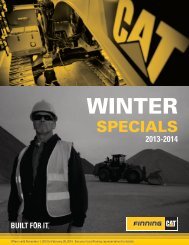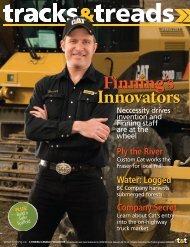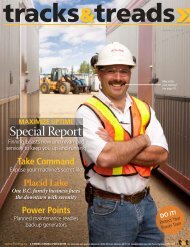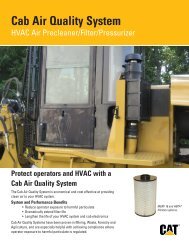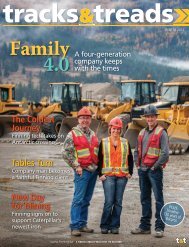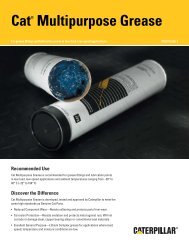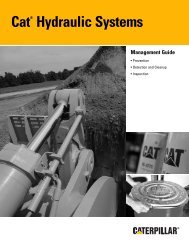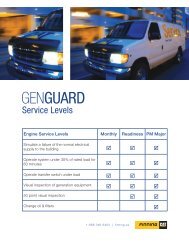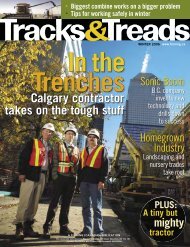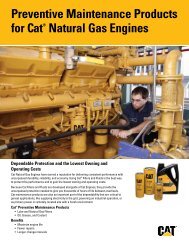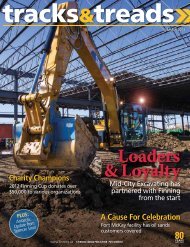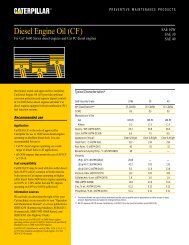Mine Altering All Systems Go - Finning Canada
Mine Altering All Systems Go - Finning Canada
Mine Altering All Systems Go - Finning Canada
- No tags were found...
Create successful ePaper yourself
Turn your PDF publications into a flip-book with our unique Google optimized e-Paper software.
303816Departments4 The <strong>Finning</strong> FocusThe year that was for ourpilots of prosperity6 GroundbreakerCharity Chopper; Cats inthe ‘burbs; Young gun;Family farm team10 The Tech ReportOnline SIS to the rescuefor customers11 Yellow IronNew products andservices from <strong>Finning</strong>20 Safety FirstSee and be seen atworksites this winter29 Yesterday/TodayNostalgia fills the air atantique earthmoving show41 Bill’s BusinessBill takes the plungeand moves from Catrental to ownership42 Count on UsA Hill With a ViewCONTENTS WINTER 2005Features12 At Home in BoomtownContractor Mickey Demers putslocal knowledge to good use inFort McMurray16 Moving MountainsHealthier metal prices revitalizethe Mount Polley mine and itsrevamped Cat fleet30 Meeting the ChallengeLords of the ring road: theAnthony Henday Drive project32 Power SurgeNew VP and organizationalstructure kick start Power<strong>Systems</strong> expansion plans36 Field TestPropak puts Cat 3616 to workat Shell's Moose Mountain gascompression station38 Civil ServicingPreventive maintenance programhelps Norex capitalize on B.C.building boomIndustry Report21 Forestry22 Not Out of the Woods YetWestern <strong>Canada</strong>’s forestry companiesfind their feet in a sector under siege25 The WOLF PackHigh-tech simulator part of a newwave of forestry training27 A Tale of Two CulturesWhy are forestry safety stats sodifferent in B.C. and Alberta?12ON THE COVERMICKEY DEMERSFORT MCMURRAY, ALBERTAPHOTOGRAPH BY GREG HALINDAwww.finning.ca Winter 2005 • TRACKS & TREADS 3
WINTER 2005 Volume 45, No. 4PUBLISHERRuth Kellyrkelly@venturepublishing.caASSOCIATE PUBLISHERJoyce Byrnejbyrne@venturepublishing.caEXECUTIVE EDITORJeff Howardjhoward@finning.caEDITORDan Rubinsteindrubinstein@venturepublishing.caART DIRECTORJennifer Windsorjwindsor@venturepublishing.caASSOCIATE ART DIRECTORVanlee Tranvtran@venturepublishing.caDESIGN & PRODUCTIONGunnar Blodgett, Catherine LizotteCIRCULATION MANAGERRob Kellyrobkelly@venturepublishing.caADVERTISING REPRESENTATIVEChristy Pfeifer McKirdycpfeifermckirdy@venturepublishing.caCONTRIBUTING WRITERSRobin Brunet, Will Gibson, Keith Haddock,Gene Kosowan, Tony Kryzanowski, ChristopherSpencer, Jim Stirling, Bill Tice, Kerry Tremblay,Jim VeenbaasCONTRIBUTING PHOTOGRAPHERSAND ILLUSTRATORSPaul Abela, Sylvie Bourbonnière, Patricio del Rio,Dustin Delfs, Keith Haddock. Greg Halinda, JasonMolyneaux, Bill TiceTracks & Treads is published to provide its readers withrelevant business, technology, product and serviceinformation in a lively and engaging manner.Tracks & Treads is published for<strong>Finning</strong> (<strong>Canada</strong>) byVenture Publishing Inc.#201, 10350-124 StreetEdmonton, Alberta T5N 3V9Phone: 780-990-0839Fax: 780-425-4921Contents © 2005 by <strong>Finning</strong> (<strong>Canada</strong>)No part of this publication should bereproduced without written permission. www.finning.ca
NEWS &REVIEWSGROUNDBREAKERBY CHRISTOPHER SPENCERGROUNDBREAKERRidingShotgunMore than 100 <strong>Finning</strong> (<strong>Canada</strong>) customers,suppliers and employees donated $100 apiecethis past summer to escort the Cat Chopper motorcyclebetween Calgary and Edmonton, witha stop in Red Deer. Their registration fees werematched dollar for dollar by <strong>Finning</strong>, bringingthe total raised for the United Way to $23,000.Built by the Teutul family of Orange CountyChoppers fame, the striking Cat Chopper featuresparts inspired by the Caterpillar line ofequipment, including grade eight bolts, bucketteeth and distinctive yellow paint. The designand assembly of the motorcycle was featuredover two episodes of the Discovery Channel programAmerican Chopper.Another highlight of the Cat Chopper’sAlberta tour was its appearance at the Champcar race this past July at Edmonton’s <strong>Finning</strong>International Speedway.Lay of the LandscapingAn advisory for the citizens of suburban Calgary:Look at all that Cat iron.Foothills Landscaping (2000) Ltd. is helpingshape many of the new subdivisions under developmenton the outskirts of the city. With demandfor new housing on the rise, mainly because ofAlberta’s ongoing energy boom, the award-winningcompany recently signed a deal with <strong>Finning</strong>(<strong>Canada</strong>) to acquire several pieces of Caterpillarequipment.Foothills carefully weighed its options beforedeciding to go with Caterpillar and <strong>Finning</strong>. “Wewere having some problems with our old dealerwho sold other equipment,” says president GeorgeHeuver, son of the company’s founder, HenryHeuver. “We put together a study of where wewanted to go. We studied all the dealers and servicecompanies in Calgary, and I think we made awise decision by moving to Cat and <strong>Finning</strong>. Wemade that decision last fall, and since then we’vebought four pieces of equipment. We switch overa little bit each year.”Recent acquisitions for Foothills include a Cat308 excavator as well as 246 and 262 skid steerloaders. The company does some large estatework, but for the most part it focuses on workingRECENTLY RETIRED FINNING CHARGEHANDMECHANIC JIM KEETCH, ONE OF MANY WHOJOINED THE CHARITY RIDEwith developers to build sustainable neighbourhoodswith plenty of parks and green spaces.Despite thestrong economy,the Heuversare resisting thetemptation tomove into othermarkets. Theyare determinedto stick to their strengths and remain a familycentredenterprise. Customer service has beena priority at Foothills since Henry launched thecompany 35 years ago.The company’s commitment to community includesa special relationship with Olds College,a post-secondary institution that focuses on agricultural,horticultural and environmental education.Henry received the college’s first Partner ofthe Year Award in 2003 for his contributions as amember of the board of directors and as a mentorto young students.“We pride ourselves on doing quality work andwe’ve been around for a long time,” says George.“The economy is strong and there is demand, butwe earn what we get.”RIDING SHOTGUN: PHOTOGRAPH BY JASON MOLYNEAUX6 TRACKS & TREADS • Winter 2005 www.finning.ca
GROUNDBREAKERYouth MovementPHOTOGRAPHY BY BILL TICEAndrew Bader was a child prodigy in the world ofCat equipment. While still a kid, the young gunused trial and error to discover which lever movedwhich part.“My dad had a backhoe,” recalls Bader, now20 years old and already at the helm of his ownCat-based business. “We used to live on an acreageand I’d dig in the field. I’d build jumps for mydirt bike.”By the time he was 13, he had created hisown part-time job clearing driveways after snowstorms.Although barely a teenager, Bader soonhad enough money to purchase his first skid steerpiece of equipment. “I bought an old skid steer forlike 10 grand or something,” he says. “I startedpushing sawdust at the horse farms and it just progressedfrom there.”“I used to print out these flyers, get on my bikeand go stuff mailboxes out in the boonies,” continuesBader. “That was all my advertising. I stayedpretty busy on the weekends and after school.”Some unusual challenges arise when you becomea successful businessman not long afterlearning how to shave. Getting the Cat from job tojob, for instance, could be a little expensive.“When I was 15, I got busted driving down abusy road because I didn’t have my license yet,”says Bader. “I got a $700 fine for that.”The police officer who pulled him over wouldcertainly be impressed if he saw what Bader isdriving these days: a Caterpillar 247B multi terrainloader.“Everything about Andrew is impressive,” saysAnte Zulj, who handled the purchase from the<strong>Finning</strong> side. “Look at where he is in his life – andhe’s only 20.“He’s a new kind of customer: young, but heknows what he wants and how to get it.”Indeed, Bader has come a long way since thoseearly days of pushing sawdust around barns andclearing driveways. “I do more contract work now,complete landscaping,” he says. “I’ve done a lotof new houses, going in and putting up retainingwalls, all the trees and installing the turf. I haven’thad to advertise for a year and a half.”Bader recently purchased a house in Surrey,B.C. And here’s the answer to the question somefemale readers might be wondering about: no, hedoesn’t have a girlfriend.“I’ve been single for the last six months,” helaughs. “I guess that’s why I work so much. I haveto keep occupied.”ANDREW BADER USEDTO BUILD DIRT BIKEJUMPS WITH A CAT. NOW,AT 20, HE’S RUNNING ABUSINESSwww.finning.ca Winter 2005 • TRACKS & TREADS 7
GROUNDBREAKERLeave it to the BiemansThe Lexion590 can cutup to 1,800bushels anhour – a pacethat helpsfarmerscontend withthe shortgrowingseason.Don’t tell the Biemans brothers that familyfarming is dead. “My mom and dad started thisfarm in 1960,” says Peter Biemans, one of threebrothers who still lives on his parents’ homesteadin the southeastern corner of Alberta. “There wasabsolutely nothing here. But we thought this wasa pretty good way of life. We have kept the farmgoing and we’re prospering from it. We’re movingforward and growing slowly, being as big as weneed to be.”The award-winning Biemans family emigratedfrom the Netherlands in 1954 – somewhatlate in the game compared to the pioneers whosettled Western <strong>Canada</strong>. The best parcels of landwere already under plough by then, so the familydecided to use irrigation techniques to developtheir farm in the dry soil near Seven Persons, justsouthwest of Medicine Hat.“When we first started out, everything wasflood irrigation, which is running water throughditches,” recalls Peter, whose farm grows a widerange of crops, including wheat and canola. “Astechnology improved, we went to a sprinkler system,putting water through pipes using pumps.In 1974, we bought our first centre pivot system.That enabled us to be more productive, becausewe could do more irrigation with less manpower.We’re up to the point now where we’re all pivotsystems – approximately 25 of them – and nowheel moves or anything like that.”Land and water conservation are importantconsiderations when farming in a climate thatcan seem inhospitable. The Biemans switched toa low-pressure pumping system, which reducesthe amount of sprinkler water lost to wind driftand improves efficiency.The brothers had efficiency in mind whenthey recently purchased a Lexion 590 combinefrom <strong>Finning</strong> (<strong>Canada</strong>). “We used to use two ofthe competitor’s combines and we needed twooperators for them,” says Peter. “We’re doing thesame amount of work now, but with only half ofthe labour and less capital investment. Overall ithas worked very well.”The 590 combine was designed to expediteharvesting in areas prone to early frosts. It’s capableof cutting up to 1,800 bushels every hour,a pace that can make an important differencefor farmers coping with a short growing season.<strong>Finning</strong> has been distributing and servicingLexion combines since 1997.Peter Biemans and his wife Janet, brotherMario and his wife Sonia, brother Ken and hiswife Marlene, and brother Roger and his wifeLynda (who remain partners in the operationbut live in Denver, Colorado) won a 2005 Bankof Montreal Farm Family Award at the CalgaryStampede for their land stewardship.PHOTOGRAPH COURTESY OF DAVE INGRAM8 TRACKS & TREADS • Winter 2005 www.finning.ca
GROUNDBREAKERBy the NumbersPercentage of surveyrespondents whothink rising gas priceswill cause financialhardship over the nextsix months:65Percentage increase inSeptember 2005 Hummer salescompared with the same periodlast year:128Number of years the Miss Crustacean HermitCrab Beauty Contest, where costumed crabsrace for the coveted Cucumber Rind Cup, hasbeen held in Ocean City, New Jersey:28Number of on-highwayvehicle engines using CatACERT technology now inservice:275,000Estimated percentagesavings in fuel economyfrom using ACERTengines:3 to 5Number of patentsearned by Caterpillaremployees since1997:3,900Smithers population:5,414Estimated amount spent inwages, goods and services inSmithers, B.C. during shootingof the Disney film Antarctica:$3 millionNumber of junk orspam mail messagessent to AT&T each day:2.1 millionSize in square feet of the Spam Museumin Austin, Minnesota, birthplace ofHormel’s spiced ham:16,500www.finning.ca Winter 2005 • TRACKS & TREADS 9
The Tech ReportTHOUSANDS OF PARTS AND PROCEDURES KEEP CAT MACHINES RUNNINGSMOOTHLY. GENE KOSOWAN DISCOVERS THAT THE ONLINE SERVICEINFORMATION SYSTEM HAS ALL THE PARTS AND SERVICE INFORMATIONCUSTOMERS NEEDSOS? SIS tothe RescueThe <strong>Finning</strong> (<strong>Canada</strong>) customer callcentre in Edmonton can be as busy as Chicago’snotoriously hectic O’Hare Airport.Like air traffic controllers guiding planesto safety, <strong>Finning</strong>’s customer service repsare hunkered down in their cubicles, providingvital information to callers on mattersranging from hydraulic parts to fuelpump assembly instructions.One recent afternoon, <strong>Finning</strong>’sDale Scott, leadhand customer supportEdmonton, had a caller from the DominicanRepublic on hold while dealing withanother customer in Russia. Consideringthat the centre receives 1,000 calls everyday, Scott’s task would have been all themore daunting if not for the Service InformationSystem used by customer supportpersonnel, parts dealers, technicians andcustomers requiring parts information.The Service Information System, SISfor short, is a website service that deliversparts and service information for <strong>Finning</strong>’sinternal use and customer base. Updatednightly, the system is current and quick forpeople with high-speed Internet. A mouseclick here and a few keystrokes there, andvisitors get instant access to more than17,000 online publications on all Caterpillarengine, machine and parts productsnew and old. They can also receive breakdownand parts identification, operationand maintenance instructions, disassemblyand assembly instructions, graphics,news and service manuals.“Without SIS,you’re pretty much hooped in terms ofwhat you can do,” says Scott. “There’s awealth of information in that system.”Dave Richards, a maintenance plannerat Luscar Ltd.’s Highvale mine roughly 80kilometres west of Edmonton, finds theSIS an invaluable resource in the course ofhis workday. Sometimes he’s on the systemchecking out parts, upgrade informationand procedures up to five times a day.“I find it to be a very useful tool,” saysRichards. “I can get around it quickly andeasily to find the things I need. I’ve been inthere often enough that I have no problemsearching for things.”Available onlinefor more than seven years, SIS is a sophisticatedarray of links and pages, whichmakes for efficient access given the volumeof information stored on it. Yet despite theinherent complexities required to put thesite together, the SIS is actually quite easyto use.It all starts by logging onto www.finning.ca, clicking on the Online Servicestab and selecting SIS. A popup windowappears where visitors enter a username and password. Once the home pageappears, users have a variety of ways tofind the parts they’re looking for. Scottsays the easiest way to find informationis to have handy a piece of equipment’sserial number and arrangement number(a designation indicating how the partwas configured when it left the factory). Byentering those numbers in the appropriatefields, a search can generally be completedwithin seconds.People who don’t have that information,which is normally found on a tagon the equipment, still have an arsenalof options, although Scott cautions thatusers may have to do a fair bit of drillingdown to find what they want.If the arrangement number isn’tavailable, for example, userscan click on a link called “AsShipped Engine” on the rightside of the page to find out howan engine was built. Typing in“turbocharger” while executinga name search will yield anextensive list of results, from lubricationsystems to air and exhaustsystems – anything involving aturbocharger.Others who are lookingfor more complete informationon SIS can search throughthe right-hand menu containing suchitems as Product Structure, Filter Search,and Remanufactured Parts Search. If thegraphic that’s onscreen isn’t clear enough,users can then click on the Assemble Disassemblelink to check out the removalprocedure and get a complete and illustratedparts breakdown. Updates are alsoavailable via such links as Engine Newsand Information Release Memos.SIS’s amenities are so massive, the sitehas become the backbone of <strong>Finning</strong>’ssupport staff. “It’s a great system,” saysScott. “It’s our number-one tool. You reallyshouldn’t have to look anywhere else forCaterpillar information.”2ILLUSTRATION BY SYLVIE BOURBONNIÈRE10 TRACKS & TREADS • Winter 2005 www.finning.ca
YELLOWIRONNew Products and Ser vices from <strong>Finning</strong>A Cat part for every needMachine near the end of its lifecycle? Get more life outof it with Cat Classic Parts, a reduced-cost line of partscovering key components. Cat Classic Parts are availableto repair axles, differentials, transmissions, hydraulicpumps, steering, swing and tandem drives, torque convertersand winches. Recently released Classic partsinclude piston/liner kits, valve kits, head assemblies,crankshafts, exhaust manifolds, mufflers and more.Meeting regulations, exceeding expectationsCaterpillar’s ACERT Technology is the pioneer whenit comes to meeting emission regulations. Next year,engines in the 175 to 750 horsepower range fall underTier 3 emissions regulations. With ACERT, Cat earthmovingmachinery will meet these requirements. ACERTintegrates new technologies with existing Cat systems,offering you clean efficient combustion that won’t prematurelydegrade parts.Numbers you can count on: 1-888-FINNING & 24/7Working in the wee hours? Need to order parts at 3 a.m.?No problem. At the <strong>Finning</strong> Customer Support Centre,we're here for you with the advice you need 24 hoursa day, seven days a week. Call 1-888-FINNING fromanywhere, day or night, to reach skilled, knowlegeable<strong>Finning</strong> equipment professionals.Caterpillar machines are built to be rebuiltThe extensive Caterpillar Certified Rebuild programincorporates the very latest Cat technology and criticalengineering updates into your machine at a fraction of thecost of buying new. After a thorough evaluation, includingmore than 350 tests and inspections and the automaticreplacement of approximately 7,000 parts, you get a likenewmachine and warranty.www.finning.ca Winter 2005 • TRACKS & TREADS 11
COMPANY PROFILE: Demers Contracting Services Ltd.Mickey DemersPHOTOGRAPHY BY GREG HALINDA12 TRACKS & TREADS • Winter 2005 www.finning.ca
Contractor Mickey Demers putshis local knowledge to good usein Fort McMurrayAt Home inBoomtownB Y W I L L G I B S O NEven though Fort McMurray has attractedthousands of people from all over <strong>Canada</strong> andbeyond, few of its residents call the northeasternAlberta city their permanent home. Most seekto make their fortune in the alchemy of turningdirt into crude and its related industries before“cashing out” in order to live in a place where –40 C isn’t a bitterfact of life for the better part of three months.The abundance of émigrés makes Mickey Demers stand out asa hometown boy made good in the booming city of 60,000-plus.And his firsthand look at the oilsands industry’s wild spasms haskept Demers thoroughly grounded, even as his company, DemersContracting Services Ltd., has grown into one of the region’ssignificant contractors.“When I was born here, there were 1,100 people here, so I’veseen the changes,” says 49-year-old Demers, who was christenedas Hector but is known to everybody as Mickey. “Today we aredeveloping some land that my father was cleared all the way backin the 1950s.”These local roots have translated into knowledge that Demersstill uses in his business, whether it’s clearing trees, buildingwinter roads or reclaiming former oilsands mines. Demersstarted his company after spending 10 years as a heavy equipmentoperator for Suncor, where he learned to run everythingfrom small dozers to heavy haulers. “Any equipment that I own,I know how to run,” he says. “That helps when you know whatkind of equipment is needed for the job.”After short stints in management for Dave Tuccaro, a highlysuccessful contractor with Syncrude, and Fort McKay GeneralContracting, Demers decided to open his own business in 1996.“I watched close friends Dave Tuccaro, Leo Roberts and JohnWilson work in business and I learned a lot from all of them,”says Demers. “My sister Dolores Romanchuk also gave me a bigpush. She owns a couple of businesses in the food services industryand she really encouraged me.”Starting with two employees, a D3 and a skid steer, DemersContracting has grown into a multimillion-dollar businessempire in less than a decade, employing 80 people and running65 pieces of heavy equipment. Big into tractors and movingtoward an excavator and haul truck operation, the Demers fleettoday includes three Cat 777 rock trucks, three Cat 160H motorgraders, tractors ranging from Cat D3 to Cat D8 in size, hydraulicexcavators ranging from 20 tonne to 85 tonne and eight rentedCat articulated haul trucks.But back in the beginning, with just the two machines, Demers’former employer, Suncor, became his first customer. “At thestart, we were very busy in the winter, doing clearing and leasedevelopment and exploration,” says Demers, whose companystill handles a drilling program for the oilsands giant. “We’vedeveloped into a year-round contracting company.”As part of his expansion into new territory, Demers landed along-term contract to upkeep roads in the Municipality of WoodBuffalo, the sprawling region more than twice as large as VancouverIsland that includes Fort McMurray, most oilsands leasesand endless acres of forest. Demers is responsible for taking careof the outlying roads, including building a 65-kilometre linkbetween Fort McMurray and the Saskatchewan border.www.finning.ca Winter 2005 • TRACKS & TREADS 13
COMPANY PROFILE: Demers Contracting Services Ltd.Suncor gave Mickey Demers his start andremains an important customerThe abundance ofémigrés makes MickeyDemers stand out as ahometown boy madegood in the booming cityof 60,000-plus.These tasks are almost second naturefor somebody who grew up in the area.“To build a winter road, you pound thefrost into the ground by clearing the snowand running across the ground with dozersand graders,” explains Demers, whosecompany was named the Fort McMurrayChamber of Commerce Business of theYear in 2001. “We also build ice bridgesby pumping water on top of the ice tofreeze it. You keep doing that until theice is 52 inches thick, when you can runloaded logging trucks across it.”As Demers’ business has expanded, sohave his equipment needs. Early on hemade a decision to go with Caterpillarand <strong>Finning</strong> (<strong>Canada</strong>), whom he regardsas a partner as much as a supplier. “Wedecided to go with one maker of heavyequipment and <strong>Finning</strong> came forwardand had the best program and guaranteedservice,” he says. “It is basically one-stopshopping, from financing to insuranceto service. I just make a call and <strong>Finning</strong>makes it happen. That’s important uphere because things move quickly.”When equipment goes down, forexample, <strong>Finning</strong> has provided replacementswithout Demers suffering downtime – two filthy four-letter words for FortMcMurray contractors. “Their pricing iscompetitive, but service, service, service isa big key for us, and our <strong>Finning</strong> sales rep,Kelly Black, is the best service providerthat I’ve ever worked with,” Demers says.“Our needs go up and down quite frequently,because we need equipment forshort-term rentals. They always seem tocome up with exactly what I need. Sometimesit’s busy up here, but they alwaysseem to have the equipment.”As a matter of company policy, DemersContracting Services usually turns over its14 TRACKS & TREADS • Winter 2005 www.finning.ca
Both clients and operators likenew equipment, says DemersContracting operations managerDel SagerDemers equipment empties a decant pond at Suncor’sextraction facility, part of a redesign of the pondEquipment operator Matthew McDonald at thewheel of a Cat 730 truck, hauling material removedfrom the Suncor extraction decant pondequipment after roughly 8,000 to 9,000 working hours. “Clientslike the newer equipment and it helps us recruit operators, whoenjoy working with new equipment,” explains operations managerDel Sager, who joined the company at the start of Augustafter 30 years with Suncor. “You have the ability to attract betteroperators with the best equipment and you have to be creative asan employer with the labour market in this community.”As the already stretched Fort McMurray labour market continuesto tighten, Demers has begun to look outside the regionfor workers. But Demers – who has hired his sons and two niecesto fill key positions within the company – will never forget wherehe comes from.“With the industry growing, they are grabbing onto as manylocals as they can,” he says. “It is putting a strain on contractors,but we’ve been able to sustain by bringing in people from outsideFort McMurray. At the same time, we’re a locally owned and aboriginal-ownedbusiness. We won’t forget our roots.”Strength in NumbersWith more than an estimated trillion barrels of oil buried beneaththe endless forests of jack pine and spruce, northeastern Albertarivals most Middle East emirates for resource riches. Like the PersianGulf states, northeastern Alberta also needs to import manyof its entrepreneurs and labour to get that oil out of the ground.That’s a trend that the Northeastern Alberta Aboriginal BusinessAssociation (NAABA) hopes to change. The group, withMickey Demers serving as president, represents 85 aboriginalownedbusinesses that operate in the region. “We’re basically aliaison that works with the oilsands industry,” says Jeff Pardee,the association’s general manager. “We look at the big picture andwork with the energy industry to try and maximize local resourcesfrom aboriginal communities.”The oilsands industry has a pretty good track record of engagingaboriginal businesses in the region, setting self-imposed targetsfor aboriginal employment as well as providing contracts toaboriginal-owned businesses. In 2004, Syncrude and Suncor –the two largest oilsands producers – awarded more than $107million and $88 million respectively in contracts to aboriginalownedbusinesses.“The industry has done a pretty good job, but the associationis a good forum to lobby them for opportunities,” says Pardee,whose group has 100 associate members, including <strong>Finning</strong>(<strong>Canada</strong>). The association has also created a partnership with theFort McMurray Chamber of Commerce and the Fort McMurrayConstruction Association – Red Link – which provides a lengthydatabase for construction companies to shop for bids from localcontractors and post their project plans and specifications.Demers, who is Métis, is also using his position as the association’spresident to help mentor the next generation of aboriginalbusiness people. “I think that’s part of the role,” he says. “You makeeverybody aware of what they are getting into, but you help themget started, even if they wind up competing with you one day.”www.finning.ca Winter 2005 • TRACKS & TREADS 15
EQUIPMENT PROFILE16 TRACKS & TREADS • Winter 2005 www.finning.ca
Healthier metal prices revitalize the MountPolley mine and its revamped Cat fleetMoving MountainsB Y J I M S T I R L I N GPHOTOGRAPHY BY PAUL ABELAFour years ago, work was put on hold atBritish Columbia’s Mount Polley mine whenmetal prices plunged. Copper and gold productionwas suspended at the open pit mineand milling operation, located 56 kilometresnortheast of Williams Lake, near the townof Likely in the province’s Cariboo region.But the world has changed a great deal since2001. Metal prices surged and remain buoyant.And after a 42-month hiatus, the revivedmine is up and running again.Mount Polley, which is owned by Vancouver-basedImperial Metals Corporationthrough its Mount Polley Mining Corporationsubsidiary, is reaping the benefits of adiligent exploration program at the nearly20,000 hectare property. The new Wight pitunder development, for instance, containscopper grades up to three times higher thancopper mined from the older Cariboo andBell deposits. This augurs well for MountPolley’s future – and it helps explain allthose smiling faces who gathered to celebratethe operation’s grand re-opening inmid September.Mount Polley was developed at an initialcapital cost of $115 million and, right fromits 1997 commissioning, has been a goodproducer for Imperial Metals. It produced133 million pounds of copper and 370,000ounces of gold from the 27.7 million tonnesof ore extracted from two pits until its temporaryclosure. Of course, getting the minefully operational again was a complex process.You can’t just flick a switch.“The start-up has gone quite well,” saysHoward Bradley, Mount Polley’s minemanager. “Basically, we started in May andJune of 2004 with the preparation of a feasibilitystudy for startup. We had to look atexpansion of the floatation and dewateringcapacity in the mill as a result of the significantlyhigher grades of ore.” That adjustmentrequired both capital costs and manpower.Another key part of the pre-productionprocess was a close examination of the mill’sequipment, which had sat idle for more thanthree years. “From the primary crusher tothe end of the filtration process, we had togo through all the equipment to make sureit was ready to operate for startup in March2005,” says Bradley.On the mining side, a good share ofequipment had been sold off to pay for careand maintenance of the operation after2001. Meeting the March startup target wasfurther complicated by difficulties findingqualified tradespeople, a pan-industry problem,notes Bradley. Mount Polley managedto deal with the challenge by using its ownwww.finning.ca Winter 2005 • TRACKS & TREADS 17
EQUIPMENT PROFILEOf course, getting themine fully operationalagain was a complexprocess. You can’t justflick a switch.employees as well as workers from suppliersin the greater Williams Lake area.Bradley says the response to MountPolley’s re-opening has been wonderful.“People in the greater Williams Lake areahave an appreciation for mining and whatit can do for the community,” he says.“Our annual site budget is around $60million – apart from capital projects –and wages are a significant part of that.”There are about 260 full-time employeesat Mount Polley. Moreover, the mine’sspin-off benefits are considerable. “If wecan buy locally, we do,” says Bradley. “Wethank everyone involved for the workthey’ve done in getting the mine ready.”Mount Polley is located at the heart ofa region with a rich mining heritage. Fivekilometres west of Likely is the BullionPit, a steadily producing gold mine from1892 to 1942. <strong>Go</strong>ld miners there usedhydro power to create a jaw-droppinghole in the ground that’s 90 metres deepand more than three kilometres long.LEFT: Eight new 785C mining trucks are trueworkhorses at Mount Polley for mine managerHoward Bradley (left) and Imperial Metalspresident Brian KynochRIGHT: The mine landscapeMount Polley’s display of power isvisually impressive as well. Consider,for example, the fleet of eight new Caterpillar785C mining trucks deliveredby <strong>Finning</strong> (<strong>Canada</strong>). They’re about fivemetres tall from the bottom tread of theirsix-metre-wide tires to the tops of theirROPS (rollover protective structures).They’re powered by 12-cylinder Cat 3512B engines, capable of generating a grosspower of 1,450 horsepower at 1,750 RPM.These mechanical monsters have a grossoperating weight of 249,480 kilograms.And the two-stage hoist cylinders takelittle more than 30 seconds to raise anddump 78 cubic metres of material.The new 785Cs complement threeolder, used machines and are true workhorsesfor Mount Polley. They run 24hours a day, seven days a week. Theirprincipal assignments are transportingore from the mining pits to the mill’scrusher, and hauling material to both thetailings storage facility and outside disposalareas.18 TRACKS & TREADS • Winter 2005 www.finning.ca
According to Bradley, Mount Polleyhad a shopping list of requirementsfor their new mining trucks. “Basically,one of the main things we were lookingat, and this was linked to the tradespeopleshortage problem, is that we neededdependability,” he says. “That was one ofthe key points.”Scheduling was also of critical importance.“We had to work closely with<strong>Finning</strong> to make sure the delivery timeson the 785s coincided with our startuptimes,” adds Bradley. “Frankly, we wouldhave had to look elsewhere if <strong>Finning</strong>couldn’t meet that.”But <strong>Finning</strong> could and did meet themine’s deadlines. And so in the longerterm, says Bradley, Mount Polley willcome to count on the maintenance servicesprovided by <strong>Finning</strong> in addition tothe reliable trucks.Caterpillar, <strong>Finning</strong> and Mount Polleyhave a solid working history together,which provides a comfort zone in anybusiness relationship. Several pieces ofCat equipment were busy at the mineprior to the 2001 production curtailment,and other Cat machines are in servicethere now beyond the 785s. This listincludes Cat 777s, D10s, an 824 wheeleddozer, a 992 wheeled loader and twomotor graders, according to Barry Bourgeois,<strong>Finning</strong>’s Williams Lake-basedmining account manager.The 785 mining trucks, Bourgeoispoints out, are all equipped with a VitalInformation Monitoring System. This isan off-board reporting software programthat records the overall health of themachine. It analyzes operator responsesand all of the machine’s parameters,which makes for more efficient vehiclemanagement.Although Mount Polley’s mine life ispegged at six years, an aggressive explorationprogram is underway to extend theresources. Information gleaned from anextensive drilling program this past summer,Bradley says, is being used to determinefuture exploration targets. Becausefrom here on in, Mount Polley does notplan on celebrating any more mine reopenings.Just anniversaries.The Cat D11R can hog a lot of material – quicklyFirst Time’s a Charm at KemessThe key to any successful industrialmachine application is finding the bestavailable equipment for the task at hand.That principle made putting a CaterpillarD11R track-type tractor to work at theKemess South open pit mine in northernBritish Columbia a very simple decisionfor Tony Marconato, the mine’s productionmanager.For one thing, Marconato is familiarwith the machine and knows what it canaccomplish. Secondly, even though noD11R had ever been used at any preciousmetal mine in <strong>Canada</strong>, the D11R was simplya very good fit for the configuration ofthe copper and gold mine.Kemess, which is owned by VancouverbasedNorthgate <strong>Mine</strong>rals Corporation, islocated roughly 425 kilometres northwestof Prince George. Concentrates from theapproximately 300,000 ounces of goldand 75 million pounds of copper producedannually are trucked by gravel road380 kilometres to the nearest railhead atMackenzie, B.C. Because the mine is in anisolated region, most of the 360 full-timestaff and hourly employees fly in and outon a two-week rotation. And because theKemess South pit is entering its last fouryears of productive life, says Marconato,working its 15-metre benches, pushingramps with minimum negative impact onproduction, are the main tasks for the newCat D11.The D11 was delivered to Kemess by<strong>Finning</strong> (<strong>Canada</strong>) in July 2005. It wentstraight to work and performed very well,reports Marconato. “The machine can packa lot of weight and operators have to getused to the power it delivers,” he says. It’sthe largest machine of its kind that Caterpillarmanufactures, and its Cat 3508Bdiesel engine produces a rated net 850horsepower at 1,800 RPM.Five Cat D10s were already on duty atKemess, but the D11 brings added versatility.The machine’s ripper capacity meansit can better handle the rugged groundconditions it encounters, says Marconato.The D11 has a blade capacity around 34.4cubic metres – so “it can hog a lot of materialquickly,” he says, including when it’sworking on the stock pile that feeds themill. The D11 proves its mettle by keepingpace with the mill’s 3,000 tonnes per hourappetite. It would take two D10s to do thesame job.Other Caterpillar support equipment atKemess includes four Cat 16 graders, Cat834s and Cat 988s. And the fleet couldgrow in the years ahead. Northgate hasinvested about $8 million in explorationand development to expand its resourcebase at the property. The Kemess Northproject, about five kilometres from theexisting pit, is a $200 million proposal thatwould extend the existing mine infrastructureby at least 11 years, until 2020.www.finning.ca Winter 2005 • TRACKS & TREADS 19
Safety FirstSAFETY VESTS ARE CRUCIAL INVESTMENTS. KERRY TREMBLAY EXPLAINSWHY VISIBILITY ON THE JOB CAN BE A MATTER OF LIFE-AND-DEATH,ESPECIALLY DURING THE WINTERNow You See ItWinter in <strong>Canada</strong> brings new meaningto the phrase “see and be seen.” While theexpression is usually reserved for puttingon your best duds and strutting for fun ona Saturday night out, in this country, in thedark of winter, it’s deadly serious.It’s rainy and misty on the BritishColumbia coast. Almost continuouslydark in the North. Heavy dumps of snowin the mountains. Blowing wind. Everyonewho works outdoors faces prettymuch the same seasonal issues – tryingto stay warm and dry while stilldoing their jobs safely. Thoughtsturn to warm mittens, heavy jacketsand the winter version of steel-toedboots for thousands of workers whospend much of their day outside, orgetting into and out of various vehicles.But that’s not the end of the list for criticalpersonal protective equipment.The enemy isn’t only the cold or wet. It’svisibility, or lack thereof. And visibility isthe last thing on just about anyone’s mindwhen it’s –30 C and that wind is blowing.Grabbing that safety vest (or evenfinding it) can be a chore in winter.And sometimes the vest, from forceof habit, ends up in the wrong spot– under instead of over the jacket. Ormaybe it doesn’t fit. With all that extraclothing changing your physique fromrunner-sleek to polar bear, that one-sizefits-mostvest doesn’t fit at all.“To the trained people who work on aconstruction site, that vest means there isa person at that location,” says Tom Fath,president of O’Hanlon Paving in Edmontonand chair of the Alberta Roadbuildersand Heavy Construction Association’ssafety committee. For the bulldozer operatoror anyone else driving a big vehicle,that vest prompts a set of mental flagspointing to where everyone is on the siteat any given time. With that in mind, keepingyour vest on and visible is important –especially in winter, Fath says, when seeingpeople is more difficult. In winter, the daysare shorter, the shadows are longer, andconstruction workers spend more timeworking in the dark or twilight.In an ideal work world, of course, therewould be no need for any kind of personalprotective equipment (PPE). There wouldbe more strict engineering controls (suchas cement barriers between workers andmachines) and administrative controls(such as only allowing people to walkaround construction sites when there isabsolutely no vehicular traffic). But thosescenarios are not realistic. PPE, everythingfrom hard hats to safety vests, is the nextline of defence.There’s a lot to consider when selectingthe proper high-visibility PPE. You can’tjust buy something off the shelf withoutthinking about it. There needs to be a hazardassessment done taking into accountthe kind of job being done. A flag person,for example, faces a different set of dangersthan a grader operator, a forklift operatoror the teenager who puts groceries in thetrunk of your car. For some jobs, moreover,a body-hugging fit or chemical resistanceis a requirement.PPE terminology itself is elaborate.It’s “occupational apparel,” not workclothes. It’s “conspicuity,” not ease ofvisibility. It’s light coloured, brightcoloured, fluorescent and retroreflective.Scientists and safetyexperts have been taking a longlook at what colours are best in thefield. They’ve tested fabrics to determinehow washable and durablethey are, as well as how visible theyare from all angles and in various kindsof light. But average workers should alsobe asking questions and doing their owntests.“Put a bunch of people together atdusk (in a safe place),” suggests Fath,“and shine a light on them. See whostands out and who doesn’t.” Whatyou see might be surprising.Workers’ Compensation Boardof <strong>Canada</strong> statistics show that threeof every 100 occupational fatalities in1998 were the result of pedestrians on footbeing struck by vehicles or mobile equipment.And that figure doesn’t include thepeople who were struck and hurt, possiblywith life-changing injuries.Provincial and territorial regulationsdo govern who must wear high-visibilityclothing. But wearing the right PPE canalso ensure you return home to your familyat night, so the choice should be easyto make.ILLUSTRATION BY SYLVIE BOURBONNIÈRE20 TRACKS & TREADS • Winter 2005 www.finning.ca
FORESTRYINDUSTRY REPORTFORESTRYjob loss, particularly in B.C. The province’s Communications,Energy, and Paperworkers union estimatesthat 40,000 forest sector jobs have been lost since 2000.The industry employs about 285,000 workers directlyand another 600,000 indirectly.In Alberta, the forest sector provides 69,000 jobsand makes significant economic contributions to morethan 50 communities. So far, Alberta has experiencedonly one mill closure: the Canfor sawmill in HinesCreek. Altas Lumber has merged its sawmilling businesswith Spray Lakes Sawmills in Cochrane, and themothballed Weyerhaeuser dimensional lumber mill inGrande Cache has been converted into a value-addedwood paneling mill by Quesnel-based C & C.In addition to operating more efficiently, companiesare taking advantage of the voracious appetite forlumber and panelboard products created by a stronghousing market in both the United States and <strong>Canada</strong>,which is being driven by low interest rates. Exportsof dimensional lumber from <strong>Canada</strong> to the U.S. hit arecord high of 20.4 billion board feet in 2004. The averageof $404 US per 1,000 board feet put last year inthe historical top five, while plywood and OSB priceshit an all-time high of $462 US per thousand squarefeet. Given the fallout from this year’s hurricane seasonin the U.S., particularly the devastation wrought byHurricane Katrina on Louisianna and Mississippi, thedemand for Canadian building products south of theborder is not expected to let up any time soon.COFI’s John <strong>All</strong>an – who is also president of the B.C.Lumber Trade Council, a body that has been providinga united B.C. voice on softwood lumber negotiationswith the U.S. – says mills operated by B.C.-based companieshave cranked down their operating costs. They arenow among the lowest cost operators on the continent.<strong>All</strong>an’s statement is supported by a survey conducted byCIBC World Markets, which shows that delivered softwoodfibre costs for Western Canadian pulp producersranked in the bottom half of 16 major pulp producingregions surveyed, and only about 10% higher thanmajor competitor Brazil. Delivery costs for EasternCanadian pulp producers, on the other hand, were thefourth highest among the 16 regions, and more thandouble Brazil’s costs.So, with all of these business moves and statisticsin mind, let’s take a look at the big picture. How arethe softwood lumber trade dispute, the mountain pinebeetle epidemic and the escalating value of the Canadiandollar really affecting the forest industry in B.C.and Alberta?Escalating Canadian DollarWhile it may not be getting as much press as softwoodlumber, the rising value of the loonie relative to theAmerican greenback has had serious repercussionsacross all corners of the sector. Over the past two years,<strong>Canada</strong>’s dollar has risen from about 65 cents to 83cents US. Each one penny rise means lost revenue of$170 million in B.C.’s forest industry (based on 2004sales) and $53 million in Alberta.In a commodity market heavily influenced by globalcompetition, this has put intense pressure on Albertaand B.C. companies to operate as efficiently as possible.One way they do this is by producing more volume.Unlike the auto industry, which has a limited numberof players, <strong>Canada</strong>’s forest industry has typically beenhighly diversified. As a result, a target-rich environmentexisted last year for companies with strong balancesheets that wanted to grow through acquisition.Hence the recent consolidation wave.Softwood Lumber DisputeCanadians companies that export softwood lumberproducts to the U.S. are slapped with a 20.2% duty.As of press time, the trade dispute that led to this tariffappeared to be finally nearing its end game.True, the American Coalition For Fair LumberImports is challenging the constitutionality of theNorth American Free Trade Agreement (NAFTA) disputeresolution mechanism, which ruled last summerthat the duty is unwarranted. But B.C. and Albertaindustry experts say that the challenge is a desperatemeasure, a tactic to delay the return of the more thanINDUSTRY REPORTLANDSCAPINGCorporate consolidation is one ofthe biggest stories in a sector which,thanks to the softwood lumber tradedispute and mountain pine beetleinfestation, seems to make headlinesvirtually every day.www.finning.ca Winter 2005 • TRACKS & TREADS 23
INDUSTRY REPORTFORESTRYINDUSTRY REPORT $5 billion in duties collected so far from Canadiancompanies. And another NAFTA ruling in mid October,ordering U.S. trade officials to review their calcula-FORESTRYtions, added more heft to the argument that <strong>Canada</strong>’ssoftwood lumber is in fact not subsidized.The one glimmer of hope for American negotiatorsB.C. FOREST INDUSTRY SNAPSHOTMills Estimated volume of logs used Pecentage ofINDUSTRY REPORT (in 1,000s of cubic metres) industry by log useLumber mills LANDSCAPING194 1,175 78.1%Veneer/OSB mills 19 5,402 6.9%Pulp mills 22 2,179 2.8%Chip mills 19 4,359 5.6%Shake and shingle mills 39 794 1.0%Other mills 112 975 1.2%Log exports 3,491 4.4%Totals 405 78,335 100.0%SOURCES: Statistics <strong>Canada</strong> and B.C. Ministry of Forests, 2004 dataFIVE LARGEST B.C.-BASED SOFTWOOD LUMBER PRODUCERSCompany Number of mills Production (in millionsof board feet)Canfor/Slocan 21 5,200West Fraser/Weldwood 21 3,719Weyerhaeuser <strong>Canada</strong> 12 2,142Tolko/Riverside/Lignum 11 2,074Interfor* 7 760NOTES: Includes lumber produced only at primary sawmills and excludes U.S. production;* Interfor production numbers an estimateSOURCES: Reprinted with permission of Logging and Sawmilling Journal, March 2005; informationprovided by WOOD Markets, RE Taylor & Associates Ltd & International Wood Markets Research Inc.TEN LARGEST ALBERTA LUMBER PRODUCERSCompany Annual production Locations(in million board feet)West Fraser Mills Ltd. 945 Hinton, Sundre, Blue Ridgenear Whitecourt, Red EarthWeyerhaeuser Company Ltd. 370 Grande Prairie,Drayton ValleyMiller Western Forest Products Ltd. 325 Boyle, WhitecourtCanadian Forest Products Ltd. 307 Grande Prairie, Hines CreekTolko Forest Industries 300 High LevelVanderwell Contractors (1971) Ltd. 150 Slave LakeBuchanan Lumber 100 High PrairieManning Diversified Forest Products 80 Near ManningNorthland Forest Products Ltd. 75 Fort McMurraySpray Lakes Sawmills (1980) Ltd. 70 CochraneSOURCE: Alberta Forest Products Association, 2004 dataFIVE LARGEST ALBERTA OSB PANELBOARD PRODUCERSCompany Annual Production Locations(in million square feet)Footner Forest Products 880 High LevelWeyerhaeuser Company Ltd. 650 Edson, Drayton ValleyTolko Forest Industries Ltd. 525 High PrairieAinsworth Lumber Co. Ltd. 500 Grande PrairieWest Fraser Mills Ltd 136 Near WhitecourtSOURCE: Alberta Forest Products Association, 2004 data;*Footner Forest Products owned jointly by Ainsworth Lumber Co. Ltd. and Grant Forest Products Ltd.is a World Trade Organization (WTO) decision that theU.S. indeed has the right to apply the duty. The WTOdecision came down after the summer NAFTA ruling.“The recent WTO ruling that the Americans are citing isnothing more than a smoke screen and a red herring,”says Neil Shelly, executive director of the Alberta ForestProducts Association.<strong>Canada</strong>, in fact, is taking the case to the Americans’own U.S. Court of International Trade. Canadianindustry players are confident the court will find thatCanadian companies are entitled to get their moneyback, just like NAFTA says. To date, B.C. and Albertacompanies could reap an estimated nearly $3 billionUS in returned duties.Mountain Pine Beetle FalloutExperts predict that 80% of B.C.’s lodgepole pine treeswill be attacked by the mountain pine beetle by 2013.Since the trees are the primary wood resource in theB.C. interior, this epidemic is having serious socialand economic consequences for many communitiesdependent on the forest industry in that region.While the problem is often associated with B.C., theMPB outbreak has serious potential consequences for<strong>Canada</strong>’s entire pine forest, which spans from B.C. toNewfoundland. According to Hideji Ono, manager ofthe forest health section of the Alberta government’sSustainable Resource Development department, allpine species except for the California-based Jeffery pineare susceptible to MPB attack. Therefore, it’s of nationalinterest that Alberta and B.C. co-operate and use thenatural barrier of the Rocky Mountains to prevent theMPB from spreading beyond the Alberta/B.C. border.So far, Ono says the MPB has been held at bay atthe Alberta border, thanks to the province’s search,destroy and containment approach to controlling anyappearance of an MPB outbreak. Alberta and B.C. havealso agreed to co-ordinate their efforts to create a bufferzone on the B.C. side of the border to prevent the MPBfrom migrating eastward through mountain corridors.In B.C., the beetle has already killed 280 million cubicmetres, or enough wood to supply every mill in <strong>Canada</strong>for one year.Challenges facing the Alberta and B.C. forest industriesare extremely dynamic and complex, much likethe biological resource on which the sector depends.The pendulum is constantly swaying for or againstcompanies in the two provinces. But this is a globalindustry, and Canadian solid wood and pulp productsare still recognized as among the highest quality anywherein the world. They are in demand. With enoughreliance, and patience, there’s no reason the industrywon’t continue to prosper.24 TRACKS & TREADS • Winter 2005 www.finning.ca
FORESTRYINDUSTRY REPORTFORESTRYINDUSTRY REPORTLANDSCAPINGThe WOLFPackDonning 3-D glasses and manoeuveringjoysticks is not what most people envisionwhen they enroll in a post-secondary educationalprogram. But for students in theWoodland Equipment Operator programat Northern Lakes College in Slave Lake,Alberta, the type of gear more commonlyassociated with video games is a majorpart of the curriculum. The program uses high-techsimulators, provided by the Woodland OperationsLearning Foundation (WOLF), to train students howto run today’s forestry equipment.WOLF, a non-profit business, was established in May2001. Its mandate is to develop training for individualsand companies involved in forest harvesting operationsin Western <strong>Canada</strong> and to work with organizationsand educational institutions, such as Northern LakesCollege, to deliver that training. Forestry companiesbelieve programs like the one in Slave Lake can attracta bright and young talent pool to their industry andensure that well-trained, skilled employees are behindthe controls of mechanical harvesting equipment.Susan Roper knows firsthand the importance ofHigh-tech WOLF simulatorpart of a new wave offorestry trainingB Y B I L L T I C Edeveloping and maintaining a skilled forestry workforce.She wears two hats in the industry: she’s the vicepresidentof Cochrane, Alberta-based Roper VenturesLtd., a mechanized logging company, and is also thepresident of WOLF.“At Roper Ventures, we specialize in steep slope logging,which means we can’t just take someone off thestreet and put them on a machine,” she says. “It wouldbe dangerous for the employee. It would be dangerousfor the rest of our crew. And it could cause damage toour equipment. As the work force ages, we have to findnew ways of attracting young people to the industry,and that is where organizations like WOLF can help.”Roper stresses that WOLF does not deliver training.“Delivery is completed by recognized institutionsand by trained educational professionals,” she says.“At WOLF, we use our expertise in the industry to helpdevelop the curriculum.”The workforce at Roper Ventures includes twograduates of the Northern Lakes College woodlandprogram. “When these two operators came to workfor us, we did not expect them to have all of the skillsof an experienced forest industry worker,” says Roper,www.finning.ca Winter 2005 • TRACKS & TREADS 25
INDUSTRY REPORTFORESTRYINDUSTRY REPORTFORESTRYINDUSTRY REPORTLANDSCAPING“The general public has the ideathat front-line forestry workers arelike Paul Bunyan, with a chain sawand an axe. The reality is that thesepeople are skilled operators who runhigh-tech equipment that typicallyranges in cost from $300,000 to$600,000 or more.”– WOLF executive directorDave Blackmore“but the learning curve was not as steep as it would befor a person off the street. They had some experienceon mechanical harvesting equipment, so we were ableto safely put them on a machine from day one, whichmeant we were getting value from these employeesright from the start.”There are 14 volunteer positions on WOLF’s board ofdirectors, including five slots for forest harvesting andsilviculture industry representatives, five slots for woodproduct manufacturing representatives, and two slotsfor reps from companies that supply equipment to theindustry. The latter includes <strong>Finning</strong> (<strong>Canada</strong>), whichhas had a seat on the board since the start and arrangedfor a Cat Foundation grant of $35,000 for WOLF to helpoffset expenses and operating costs.“<strong>Finning</strong> was instrumental in helping WOLF obtainour Caterpillar 1051 feller buncher 3-D rear projectionsimulator,” says WOLF’s executive director, Dave Blackmore.“This simulator can give students the true feelingof what it is like to run one of these machines.” The1051 simulator features an actual operator’s seat andcontrols. “When an operator wears the 3-D glasses anduses the controls,” says Blackmore, “the simulator givesthem a proportional view of what they would see inreal life.”WOLF has two other simulators that are used bycolleges and at career fairs, including a Cat 320 with aDenharco processing head that runs from a laptop computer.“It’s great for the students to work on the simulatorsand get an idea of what it will be like in the woods,”says Blackmore. “At career fairs, these high-tech toolshelp us project the right image for the industry. Educationalprograms are key to improving the image ofthe industry and to attracting new employees. The generalpublic has the idea that front-line forestry workersare like Paul Bunyan, with a chain saw and an axe,” hesays. “The reality is that these people are skilled operatorswho are running high-tech equipment that typicallyranges in cost from $300,000 to $600,000 or more,and they may be processing a couple of million dollarsworth of timber per year with that equipment.”WOLF is by no means the only organization workingto improve educational standards within the forestsector. The Forest Industry Suppliers and Logging Association(FISLA) is a national not-for-profit organizationbased in Edmonton. It administers the Alberta MasterLogging Program (MLP), which promotes continuingeducation among the province’s logging community.“Programs like the MLP are commonplace throughoutthe U.S., but in most states they are legislated,”says Ken Glover, FISLA’s executive director. “Ourprogram is voluntary, with the objective of elevating,promoting and rewarding logging contractors thatactively invest in continuing education for the benefitof their business, the environment, safety and the forestindustry.”26 TRACKS & TREADS • Winter 2005 www.finning.ca
FORESTRYINDUSTRY REPORTFORESTRYINDUSTRY REPORTLANDSCAPINGA Taleof TwoCulturesYou’re working on rough, isolated terrain.In hostile weather. Surrounded by insectsand potentially dangerous wild animals.Now try manoeuvering equipment – onthat terrain, in that weather, surroundedby those pests and predators.People who work in the forest sectorface many external challenges. But healthand safety issues, and attitudes, are no less of a concern.In forestry, as in most heavy industries, losingyour focus for a minute can cause serious injury ordeath. Neighbouring provinces British Columbia andAlberta, however, with distinct topographies, governmentregimes and workforce composition, have vastlydifferent forestry health and safety experiences.“It’s a good news story here,” says Lloyd Harman,director of health, safety and transportation for theAlberta Forest Products Association (AFPA). Many forestrycompanies in the province have been involvedin developing health and safety systems for 14 years,since the first Certificate of Recognition (COR) processwas developed in Alberta. “The majority of the forestrycompanies, and up to 50% of contractors, haveWhy are forestry safetystats so different in BritishColumbia and Alberta?B Y K E R R Y T R E M B L A Ytheir CORs,” says Harman. The certificate is part of aprogram initiated by Alberta Human Resources andEmployment, with financial incentives from the AlbertaWorkers’ Compensation Board (WCB). Companiesdevelop a safety program which is audited every threeyears by independent, trained safety auditors.Forestry safety in Alberta has evolved to a newphase, according to Harman. AFPA members are currentlydeveloping Forestry Industry RecommendedPractices. These are standardized guidelines for taskssuch as equipment lockouts and isolation proceduresin mills, or similar procedures out in the field. There’salso a new pre-job checklist that helps workers identifyand control hazards in non-routine tasks not coveredby formal hazard assessment processes. This couldmean, for example, that a worker who has to pull apump at a particular jobsite will spend two minutespreparing the site before actually doing the job – or twohours, depending on the complexity of the task. Thiseliminates much of the risk associated with encounteringthe unexpected.Another AFPA member-driven project is the DevelopedBehaviour Observation System, which allowswww.finning.ca Winter 2005 • TRACKS & TREADS 27
INDUSTRY REPORTFORESTRYINDUSTRY REPORTFORESTRY“Eight fallers are killed every year inour forestsINDUSTRYandREPORTthat number hasn’tLANDSCAPINGchanged since the 1920s. Things haveto change.”– Don Dahr, WorkSafeBCemployees to identify at-risk behaviours of otheremployees. The objective is not to set up a worker forreprimand, but to identify barriers to improved safetyand address them from a system-wide perspective.In Alberta, 12 people died in the logging and woodlandsoperations industry between 1995 and 2004, thelast year for which data is available, according to theprovince’s WCB. Even though the sector is much smallerin Alberta than B.C., these statistics show how muchof a challenge B.C. faces. The province’s 2004 ForestSafety Task Force report says that, “the forest sector hasthe highest death rate of all industries in B.C. Between1993 and 2002, there were 250 forest-related deaths.The sector’s serious injury rate is about six times higherthan all other high-risk industries in B.C.”The B.C. task force brought together groups from allcorners of the province’s forest industry. They analyzedthe safety culture in the business, examined work practicesand identified key opportunities and challenges.The result of their recommendations is the new B.C.Forest Safety Council, which has secured a long-termfunding commitment from industry and WorkSafeBC(formerly the province’s WCB).The way to reduce the fatality and serious injuryrate, according to Don Dahr, manager of industry services-primaryresources at WorkSafeBC, is to changethe culture in the forest. Right now, he says, the prevailingattitude in the woods is, “I’m a macho man.No risk is too much for me.” Yet just about everyoneworking in the woods knows someone who has died orbeen severely injured on the job. And in the first eightmonths of 2005, the 23 fatalities and 57 serious injuriessuffered by forest workers show how necessary arole WorkSafeBC is playing.Dahr says that the new council has been busy. Anincentive program similar to Alberta’s COR is beingdeveloped and will be ready for implementation in2006. The council has also hit the ground running onthe training side. “Eight fallers are killed every year inour forests and that number hasn’t changed since the1920s,” says Dahr. “Things have to change. A new certificationsystem for over 4,000 tree fallers in the provincehas been implemented.”Training has always been required, says Dahr, butcertification regulations haven’t been enforced. Nowthey will. Two-thirds of fallers in the province havebeen trained (as of September 2005) and the rest willbe certified by summer 2006. Fallers with two yearsexperience take an exam, are field-tested, then grandfatheredinto the program. New fallers will get 30 dayscouncil-guided training at colleges throughout B.C.Supervisors are also being trained to work with the fallersand programs are being developed for log haulers, agroup that suffers four to five fatalities per year.The B.C. Forest Safety Council’s slogan is “unsafeis unacceptable.” Its mission, says the council’s TannerElton, is ensuring that this slogan “becomes a descriptionof how the forest sector deals with safety and notjust another slogan.”28 TRACKS & TREADS • Winter 2005 www.finning.ca
Yesterday/TodayNOSTALGIA FILLS THE AIR AT ANTIQUE EARTHMOVING EQUIPMENT SHOW.KEITH HADDOCK TAKES IN THE SIGHTS AND SOUNDS OF THE PAST, ANDTAKES A TRIP DOWN MEMORY LANEPHOTOGRAPHY COURTESY OF KEITH HADDOCKRumble FeverThe Historical Construction EquipmentAssociation’s annual exposition took meback to my childhood. The most distinctivesound I heard at the show – held inearly August at the Reynolds AlbertaMuseum in Wetaskiwin, south of Edmonton– came from a 1954 3T-series CaterpillarD7 equipped with a cable-operatedangle dozer. This particular D7 is ownedby Mel Thompson of Barrhead, AlbertabasedMel’s Cat Service Ltd. But I rememberlistening to D7s just like it, with theirdistinct “hollow” throbbing sound, workingnear my home in Sheffield, Englandback in the 1950s.That unique sound comes from theCaterpillar D8800 diesel in the 3T D7.Caterpillar built a whopping 28,058 ofthese units from 1944 to 1955. The sameengine, with different power ratings, wasalso fitted in earlier D7 models such as the9G and 7M dating back to 1935. <strong>All</strong> told,Caterpillar produced a staggering 55,448D7s equipped with the D8800 engine.The three-day antique earthmovingexposition, dubbed the “Greatest Showon Earthmoving,” was the most popularevent held at the Reynolds Museum since itopened in 1992. Staged outside the UnitedStates for the first time, it drew more than9,000 visitors, volunteers and exhibitors.People came to see – and hear – fleets ofold cable excavators, crawler tractors,scrapers and graders, few equipped withmufflers. These machines were broughtback to life, many restored to like-newcondition by their proud owners, and wereused to build permanent roads and facilitieson the museum grounds.In relative silence, 40 horses moveddirt the way it was done in the early 20 thcentury. Sixteen horses were hooked to a1905 elevating grader, 12 in front and fourpushing at the rear, while the grader’s conveyorloaded woodenbottom-dumping wagons,each drawn bytwo horses. This popularsight attracted largecrowds. Most visitorshad never before seenearth moved with realhorse power!Mel Thompson’sD7, on the other hand,is rated at 90 drawbarhorsepower. It’sstripped down andtotally rebuilt withreplaced Caterpillarcomponents such asnew steering clutchesand brakes. “It’s likea new machine,” saysThompson, “and I stilluse it for productivework on my ranch.”Visitors also cameto see modern equipment prov ided by<strong>Finning</strong> (<strong>Canada</strong>), amajor sponsor at theshow. A big eye-catcherwas the new D8T equipped with an angledozer. It attracted a steady stream of peoplewho examined its features and, yes,many sat in the seat as well.Read all about the fascinating story ofCaterpillar’s crawler tractor evolution in thebook Classic Caterpillar Crawlers by KeithHaddock and Eric C. Orlemann. To ordera copy, send $39.95 postage paid to ParkCommunications, 29 Sunrise Way, Priddis,Alberta, T0L 1W0. Or phone 403-931-1670for more details.1. DAYS OF YORE: Most people have never seenearth moved with real horse power2. NOT JUST FOR SHOW: Mel Thompson still useshis 1954 Cat D7 to work his ranchwww.finning.ca Winter 2005 • TRACKS & TREADS 29
MEETING THE CHALLENGELords of the Ring RoadP H O T O G R A P H Y B Y D U S T I N D E L F SA recently paved bridge deck over Gateway BoulevardLoading a Cat 972G wheel loader at the Lafarge asphalt plantPCL’s Stephen King (left) and <strong>Finning</strong>’s John Gallimore30 TRACKS & TREADS • Winter 2005 www.finning.ca
One of Sureway’s Cat 385B excavators loadsa truck to haul dirt to the roadwayWorkers build a mechanically stabilized earth (MSE)retaining wall, which will be put down by Cat skid steerThe Cat 657E tractor, a flagship in theSureway fleet, moving clayOne of Lafarge’s Cat 14H motor graderspaving base course groundAs cities expand, traffic increases. As more vehicles hitthe road, new routes are needed. Building transportationinfrastructure is a challenge that requires expertise,meticulous planning, precision and teamwork.The Anthony Henday Drive Ring Road is a publicprivatepartnership that fi ts this bill. Eleven kilometres ofhighway with 24 bridges and five interchanges, the southeastportion of Edmonton’s ring road will significantlyreduce congestion when it opens in October 2007. Underthe auspices of Access Roads Edmonton Ltd. (AREL) –the team assembled to design, build, finance, operate andmaintain the route – construction began this past spring.And naturally, Cat iron was called into action.“The size and versatility of the equipment we havemake Cat a perfect fit,” says <strong>Finning</strong> (<strong>Canada</strong>) majoraccounts manager John Gallimore. “We can do a range ofjobs onsite and supply a total product line, including skidsteer loaders, wheel loaders, motor graders, scrapers andexcavators as well as pavers and compactors.”PCL Construction Management Inc. is managing allconstruction and design related activities for AREL. PCL-Maxam, A Joint Venture is building the bridges and overpasses,while Sureway Construction Management Ltd.will do the earthworks and Lafarge <strong>Canada</strong> Inc. is completingthe surface works. Marshall Macklin Monaghanand Stantec Consulting are providing design services,Transportation <strong>Systems</strong> Management Inc. will do themaintenance and rehabilitation, and ABN AMRO BankN.V. is providing the financing.“The AREL team works very hard to maintain a partnershipattitude,” says Stephen King, PCL’s offi ce constructionmanager for the Anthony Henday project. “Fromthe pursuit phase to now, the end of the first constructionseason, we have worked together with each team member’sinterests in mind, overcoming many potential costand schedule concerns.”www.finning.ca Winter 2005 • TRACKS & TREADS 31
DIVISION PROFILE: <strong>Finning</strong> Power <strong>Systems</strong>Juan Carlos VillegasPHOTOGRAPHY BY DUSTIN DELFS32 TRACKS & TREADS • Winter 2005 www.finning.ca
New VP and organizationalstructure kick start Power <strong>Systems</strong>expansion plansPower SurgeB Y R O B I N B R U N E TOne of <strong>Finning</strong> International’s many strengthsis the company’s ability to tap into its globalresources in order to achieve corporate goals.In its quest to expand the Power <strong>Systems</strong> businessto $1 billion in revenue by 2008, the parentcompany has turned to <strong>Finning</strong> (<strong>Canada</strong>).And it found an ideal man for the job in Santiago, Chile.As he surveys an unfamiliar landscape through the windowsof the Edmonton headquarters of <strong>Finning</strong> (<strong>Canada</strong>) Power <strong>Systems</strong>,Juan Carlos Villegas, the division’s vice-president, says he’skeen on immersing himself in what he calls the “engine side ofthe business.” That description is perhaps a bit of an understatement.The Power <strong>Systems</strong> unit handles everything from back-upstandby generator sets (such as the one in place for Vancouver’sYVR Airport baggage handling systems) to system design assistance(for companies working in the Alberta oilpatch) and evenlarge quantities of portable rental air conditioners (such as theones used during the filming of Hollywood movie Cat Womanin Vancouver).Regardless, Villegas, who moved to <strong>Canada</strong> from Chile lastJuly, is confident he can double the division’s capacity. Despitethe challenges of adjusting to a new culture and bracing for hisfirst prairie winter, Villegas talked to Tracks & Treads about howpast experiences have prepared him for the task ahead.“In Chile,” he says, “I was the vice-president of the company’sSouth American mining division, and in five years my team andI doubled our activity. This was a massive operation involvingover 2,000 people. Although I’m still learning the Canadian wayof doing business, I’ve received so much support from co-workersthat I’m certain we can achieve the same degree of expansionup here.”It’s tempting to imagine Villegas toiling in a distant landwhere customs and routines are steeped in exotic tradition – anotion given credence by his courtly bearing and appearance.But in order to immerse himself in all things Canadian, he prefersnoting the similarities in both cultures. “Canadians arerenowned for their entrepreneurial spirit and independence, andso are Chileans,” he says. “Back home we work hard, our taxesare extremely low, and virtually everything that could be privatizedunderwent the transformation long ago. Our economiesare also similar inasmuch as they’re both dependent on commodityproduction. That’s why, although I may have challengesadjusting to Western <strong>Canada</strong> on a personal level, I find it entirelynatural to apply the skills I honed in Chile over here.”From an early age, Villegas, who is now 50, wanted to excelin business. “Global business, not local,” he stresses. “Becauseif you focus on the latter you’re at a huge disadvantage. I alwaysdreamed of working for an international company.” He went tothe United States as a student, attending the University of California’sIrvine campus, where his father chaired the Spanishand Portuguese departments. (“My dad still lives in the U.S.,”says Villegas, “as do my three sisters, and my younger brotherworks for Caterpillar in Florida”). When he returned to SouthAmerica, he spent 16 years working for competitor equipmentcompanies in Argentina, Chile, Peru and Bolivia. Then, in 1998,he was recruited by <strong>Finning</strong>: “I figured that if I couldn’t beat thecompetition, why not join them?”www.finning.ca Winter 2005 • TRACKS & TREADS 33
DIVISION PROFILE: <strong>Finning</strong> Power <strong>Systems</strong>The Power <strong>Systems</strong>division permeates awide market, supplyingeverything from backupgenerators to mobilepower plants and customelectric power packagesfor locomotives.Other than acknowledging that<strong>Finning</strong>’s South A merican miningendeavours kicked into high gear underhis jurisdiction, Villegas tends not towax on about his accomplishments. “Weformed an excellent team who should getfull credit for allowing us to achieve suchenormous success,” he says. Success cameat a price, however: at his office in Santiagohe worked, delegated and was oncall 24 hours a day, seven days a week –much to the frustration of his wife Dinaand his now 17-year-old daughter, MariaJose. So when <strong>Finning</strong> Internationaloffered him the task of becoming vicepresidentof Power <strong>Systems</strong> via the company’sexecutive development program,he jumped at the opportunity. “I wasalways interested in coming to <strong>Canada</strong>,”he says, “and because this job was somewhatless demanding in terms of extratime and travel than my previous duties,it would theoretically allow me time formy family.”That said, Power <strong>Systems</strong> is no smallportfolio. The division permeates anunusually wide market: uninterruptedpower supply (UPS) devices for hospitalsand casinos, custom electric powerpackages for railroad locomotives, and34 TRACKS & TREADS • Winter 2005 www.finning.ca
PHOTOGRAPH COURTESY OF NATHEN GALLAGHER/CROWSNEST PASS HERALDself-contained mobile power plants for remote mines are justthree examples. This diversity, in fact, was one of the factorscompelling Villegas to accept the challenge of doubling thedivision’s output on a global basis. “My official assignmentlength is between three and five years with an option of stayinglonger if everything turns out okay,” he says. “Is <strong>Finning</strong>’sgoal feasible in this time span? Absolutely. Taking Alberta as astarting point, just look at the health of your economy. <strong>All</strong> thenecessary ingredients are in place.”Restructuring the division was perceived as the best wayto achieve success. On September 15, the new organizationalstructure for <strong>Finning</strong> (<strong>Canada</strong>) Power <strong>Systems</strong> was unveiled.To capture growing market opportunities, the focus of the neworganization will be on customer segmentation and productsupport development. Accordingly, four experienced managershave been appointed to lead industry sector-specific marketingefforts: Jim Stibbard, Oil & Gas; Richard Plain, EnergyPower & Rentals; Bradley Beebe, Marine & Industrial; andHarold Denenfeld, On-Highway Engines. Three senior Power<strong>Systems</strong> employees have also been appointed to lead businessunits that will partner with the managers to provide the highdegree of technical product support required by customers:Mark Balaski, Director Product Support; Darryl McCulley,Director Engineered Solutions; and Nikki <strong>Go</strong>odman, ManagerMarketing and Business Processes.Given the new structure and growth strategies that arealready being implemented, it’s unclear what amount of sparetime – if any – Villegas will have to absorb the Canadian culturehe is so keen to understand. Between endless series ofmeetings, he scrambles to ensure that his family feels as comfortableas possible.As for Maria Jose, she is braving the Edmonton publicschool system. “She’s beginning to fit in,” Villegas says, “butafter being schooled privately in Santiago she has her work cutout for her in a school that contains 1,200 people!”Villegas’s last cultural challenge is to experience a toughprairie winter. The image of a Chilean wearing so much clothingthat he resembles the Michelin Man prompts a goodnaturedlaugh from Villegas. “I’ll escape some of the cold byreturning to Chile for three weeks in December, but everyoneis telling me to watch out and be prepared when I come back!“ he says. “That’ll be quite an experience – a suitable initiationinto my new life here.”Power to the People“It looked like devastation.” That’s how municipal councillorGail Sygutek describes southwestern Alberta’s Crowsnest Passafter nearly half a metre of wet snow buried the region on Sunday,September 11. The freak late-summer blizzard knockedout power to almost 4,000 homes, forcing emergency crews toscramble in the cold to move elderly residents to makeshift shelters.As hospitals and other vital facilities started backup generatorsto keep their doors open, Fortis Alberta crews discoveredthat the snow had broken at least 50 power poles.Fortis lost no time phoning <strong>Finning</strong> Power <strong>Systems</strong> sales repDave Carkner, who was in Edmonton getting ready to enjoy abarbeque lunch. Fortis knew, of course, about the Power <strong>Systems</strong>division’s ability to provide equipment and turnkey serviceduring emergencies – and although the Crowsnest Pass blizzardwas undoubtedly the worst storm of the year, it proved to be justanother assignment for <strong>Finning</strong> Power <strong>Systems</strong>.“We had four XQ2000s, the largest temporary diesel generatorsmade by Caterpillar, available in our Calgary branch,” recallsCarkner. “Each of these units produce two megawatts and weigh74,900 pounds, an ideal resource until permanent power couldbe restored.”Finding immediate transportation was key to the operation’ssuccess, but with the help of Mullen Trucking, Rebel Transportand staff at <strong>Finning</strong>’s Calgary office, Carkner was able to coordinatethe delivery – all from his dining room table. <strong>Finning</strong> technicianBrian Brent, who holds heavy duty and electrical tickets,accepted the call to go to the Pass. “People rely on you to providepower,” he says, “so you have to be on call 24 hours a day.”“Brian and four trucks reached the Pass late Sunday andpositioned the generators beside substations,” says Carkner.“Three of the trucks went home, and in the freezing weatherBrian methodically rigged the wiring and made the units functional.”Two units were operational by Monday night, and theremaining two were running the following day. <strong>Finning</strong> Shellteams from Lethbridge and Medicine Hat provided fuel for thegenerators and ensured they were topped up regularly.Crowsnest Pass residents may remember the blizzard as oneof the more severe storms to hit their region in recent years,but Carkner takes a more philosophical view. “These things happen,and we’re well-prepared to cope with the unforeseeable,”he says. “We pride ourselves in being a single source for totalemergency response.”www.finning.ca Winter 2005 • TRACKS & TREADS 35
FIELD TESTCat TacklesMooseThe Cat 3616 has earned a reputation as one of themost powerful and efficient natural gas-fueled generatorson the market. It delivers more than 4,700horsepower and, at the same time, reduces operatingcosts for businesses. And it’s fuelling developmentin the natural gas industry by helping energycompanies extend the life of existing gas fields as well as tapinto new reserves.“Producers everywhere are looking for more efficient waysto get their natural gas to market and demand for engines inour 3600 series is huge,” says <strong>Finning</strong> (<strong>Canada</strong>) sales rep AndyKavanaugh. “When producers have a huge volume of naturalgas to move, they need an engine with high horsepower. The3616 can easily compress gas to as much as 7,000 PSI (poundsper square inch) and help producers extract every drop of naturalgas. This engine is absolutely the best in its class.”Propak puts the Cat 3616 to work at Shell’sMoose Mountain gas compression stationB Y J I M V E E N B A A SThis kind of performance is the reason why Airdrie, Alberta-basedPropak <strong>Systems</strong> suggested that Shell <strong>Canada</strong> considerthe 3616 for its new gas compression station at Moose Mountain,about 45 minutes southwest of Calgary. Shell wanted toboost production at the site and contracted Propak to build anew compressor station. “There was a lot of discussion aboutthe type of machinery best suited for the project, in termsof how much horsepower to put in and how much load wasneeded,” says Ron Delisle, Propak’s director of marketing. “Werecommended a couple of different gas compression enginesfor Shell and gave them some references to help them make thefinal decision. They checked out their options and were quiteeager to use the 3616.”Although Moose Mountain has a large volume of naturalgas, the pressure is low and needs to be pumped up beforeit can be fed into the pipeline system. The 3616 was perfect36 TRACKS & TREADS • Winter 2005 www.finning.ca
The processing systems at Moose Mountain (left) get a boostfrom the high horsepower of the Cat 3616 engine (right)PHOTOGRAPHY BY PATRICIO DEL RIOfor the task because it can compress large volumes of gas andincrease the PSI to levels suitable for pipelines. Moose Mountaingas is fed into a pipeline and delivered to the JumpingPound Complex, a Shell operation near Calgary that processesmore than 4.5 million cubic metres of raw gas every day.“They did some drilling and discovered they were capableof increasing production. The limitations were the pipelineand compression,” explains Delisle. “They had capacity at theJumping Pound plant and additional reserves in the MooseMountain region. But they needed to do some work to increasecapacity. It’s actually part of a project to break up a bottleneckin the area and get more gas to Jumping Pound.”Beyond its ability to pump up pressure, the Cat 3616 iseconomical to run. According to Kavanaugh, annual operatingcosts are up to $250,000 lower than similar machines. Theengine features electronic controls that offer superior performance,excellent fuel economy and dependability. Cat enginesalso boast uptimes of 98% or higher, which translates into lowoperating costs. “Twenty years ago, if you had an engine with90% uptime, you’d have been happy,” says Kavanaugh. “Ourengines are running at 98% now. That’s a huge advantage forthe end users and saves a tremendous amount of money. Ourengines use state-of-the-art technology. Car engines todayhave a mechanical efficiency of about 42% for the really efficientvehicles. Our engines do anywhere from 35% to 40%,which is remarkable considering they are so large.”The Cat 3616 at Moose Mountain is one of only six in <strong>Canada</strong>,but Delisle expects to see more in the future as energycompanies look for ways to boost production in the aging gasfields of Western <strong>Canada</strong>. “The is one of the first high-horsepowerengines to be used in North America,” says Delisle. “Bighorsepower is more typical in other parts of the world, butmore is needed as the Western Canadian Sedimentary Basindeclines in pressure. We will continue to add horsepower tomaintain gas delivery.“There’s two elements at work,” he continues. “Unconventionalgas like coalbed methane requires tremendous amountsof compression and the existing conventional reserves needto add compression to maintain production and marketing asthey decline in pressure. You basically have to add horsepowerto achieve both those goals.”<strong>Finning</strong> (<strong>Canada</strong>) and Cat will undoubtedly play a bigrole in the move to higher horsepower in North America.The quality of Cat engines is one of the reasons Propak hasalready installed Cat at oil and gas facilities across the globe.As a world leader in the design and construction of oil andgas processing facilities, the company demands the strictestquality when getting components for its systems. “We’re workingon projects together in South America, eastern Europe, theUnited States,” notes Kavanaugh. “Propak will buy an enginefrom us, a compressor from another OEM (original equipmentmanufacturer) and put them together in one package. Theyare shipping our engines to locations across the globe. Theirreputation is on the line and they won’t settle for less than thehighest standard of quality.”That commitment to quality has played a big role inPropak’s phenomenal growth since it was established in 1976by Rod McPike. The company has 700 employees around theworld and is involved in a wide range of services related to oiland gas processing, from engineering and feasibility studies toconstruction design and plant manufacturing. “We do prettywell everything when it comes to oil and gas processing equipment,”says Delisle. “Compression is just one stream of that.”And the Cat 3616 is just one piece of the puzzle, albeit avery powerful piece.www.finning.ca Winter 2005 • TRACKS & TREADS 37
EQUIPMENT PROFILE38 TRACKS & TREADS • Winter 2005 www.finning.ca
Preventive maintenance program helpsNorex Civil Contractors capitalize onLower Mainland building boomB Y T O N Y K R Y Z A N O W S K ICivil ServicingPHOTOGRAPHY BY BILL TICE“This is as good a time as any to talk,”Carey Reutlinger says into his cellphone.The owner of Norex Civil Contractors Inc.is standing at the bottom of a recently excavatedtrench, with the sound of steel pipesclanging in the background. Despite theecho, and the unconventional setting, he’swilling to be interviewed now.His company is that busy.Norex Civil Contractors, based inAbbotsford, British Columbia, specializesin heavy institutional and commercial constructionjobs in the province’s boomingLower Mainland. Only a few years ago, thearea was a business wasteland for companieslike Norex, according to Reutlinger, becauseof an unfriendly business climate in B.C. “Ifyou came here five years ago, you’d thinkyou were on a different planet,” he says.“We’ve gone from a government that didn’tbelieve in construction projects to a progressively-mindedgovernment, and that hasreally sparked the economy.”Thanks to its experience in heavy civiland subdivision construction, undergroundservicing, and road building, Norex CivilContractors is in demand. It has worked onhigh-profile projects such as the TransLinkVancouver Transit Centre development, astorage and maintenance facility for 400busses, 188 trolleys and 40 articulatedtrolleys, as well as the 83,000-square-footMichael Smith Laboratories on Vancouver’spicturesque University of British Columbiacampus. It also regularly sub-contractsits services to Bird Construction CompanyLtd., one of <strong>Canada</strong>’s top 10 general contractors.Because of this workload, Norex cannotafford to lose time and productivity toequipment going down.After starting with a single excavator sixyears ago, Norex Civil Contractors today has11 pieces of equipment. And over the past 18months, the company has been in the processof converting all of its fleet exclusivelyto Caterpillar machines. The revamped fleetnow includes two 330CL excavators, two320CLU reduced tail swing excavators, twoCS433 smooth drum compactors, a 268B ITskid steer and a D4G crawler dozer.“Dealer support is probably the biggestreason for heading in that direction.,”Reutlinger says about the conversion toCat. “With Caterpillar equipment, you aredealing with a solid franchise in <strong>Finning</strong>. Ican’t tell you enough good things about my<strong>Finning</strong> representatives, Charles Kemp andEd Lingel. In fact, it’s been a real pleasuredealing with all departments of <strong>Finning</strong>.”www.finning.ca Winter 2005 • TRACKS & TREADS 39
EQUIPMENT PROFILEReutlinger purchased his first excavatorfrom one of <strong>Finning</strong>’s competitors.He describes the experience of trying toarrange something as simple as warrantyservice as a real eye-opener – largelybecause the company he bought fromchanged hands three times in four years.“In my view, the strength of the dealershipis paramount,” he says. “We’ll bedealing with <strong>Finning</strong> next year, and inall likelihood, they’ll still be around in10 years.”Signing a preventivemaintenance agreementhas eliminated theneed for a maintenanceshop, a service truckand mechanics. Ithas also resulted inzero downtime onequipment.In addition to opting for Caterpillarreliability, Reutlinger has taken a newapproach to maintaining his equipmentfleet – something that’s especiallyimportant in today’s busy constructionclimate. He has signed a two-year CustomerSupport Agreement with <strong>Finning</strong>to look after all his preventive maintenance(PM) and servicing needs, forboth his Caterpillar and non-Caterpillarequipment. This arrangement haseliminated the need for a maintenanceshop, a service truck and mechanics. Ithas also resulted in zero downtime onhis equipment.“Building a shop on unservicedindustrial land down here, you are lookingat a cost pushing $400,000 per acre,”Reutlinger says about pricey LowerMainland real estate, “and a properlyassembled service truck will run you$100,000. Also, taking downtime usingour own resources during productivework hours to conduct preventive maintenancewas very costly.” In other words,because <strong>Finning</strong> conducts its PM serviceafter-hours, or when machines are notrunning, this minimizes downtime forthe customer.“One of the other benefits of oursupport agreement with <strong>Finning</strong> is thatwhen their mechanics come out to dothe work, they also inspect the equipment,”adds Reutlinger. “If there areany other service issues that our operatorshaven’t picked up on, they’ll beaddressed at that time as well.”Between company management and<strong>Finning</strong>’s dedicated customer serviceteam, the hours on each piece of equipmenthas worked are logged, whichhelps ensure that Caterpillar’s recommendedPM service schedule is followed.If a service team member notices that aparticular piece of equipment hasn’tbeen serviced for some time, they willgive the customer a courtesy call, alertingthem that it may be time to book aservice call.Customer Support Agreements areavailable on any piece of equipment that<strong>Finning</strong> sells, and can be tailored to suitbusiness requirements. For instance,some equipment owners negotiate a setfee per service call, while others opt fora pay-as-you-go method, paying for theamount of time it takes to complete aservice call.<strong>Finning</strong> product support representativeCharles Kemp, who pays attentionto the quality of service support providedby other equipment dealers, says<strong>Finning</strong>’s Customer Support Agreementsoffer many benefits: parts are readilyavailable – usually the same day or overnight– and service is completed onsitewith well equipped field trucks andhighly-trained technicians. <strong>Finning</strong> hasalso introduced a “no overtime charge”policy that applies to all Customer SupportAgreements. Incidentally, the noovertime charge policy also applies toregular shop and field calls Mondaythrough Saturday.Reutlinger says the quality of <strong>Finning</strong>’sPM service has a had a significant impacton Norex Civil Contractors in a coupleof ways. It has helped his company meetstrict environmental guidelines regardingonsite equipment maintenance, andit has boosted equipment resale value.It’s becoming more and more commonplaceto find strict environmentalregulations about on-site equipmentservicing written into the terms of acontract, according to Reutlinger. Tosatisfy these regulations, <strong>Finning</strong>’sservice trucks are configured so that oilcollected on site is transferred from theequipment directly to the service truckwithout any danger of a leak.Also, by signing a support agreementwith <strong>Finning</strong>, the liability is transferredto <strong>Finning</strong> in the event of environmentalproblems resulting from a servicecall. Furthermore, because <strong>Finning</strong> peopleare doing the service work, it meansthat Norex saves resources because itdoes not have to train its own employeeshow to maintain equipment accordingto new, more stringent environmentalregulations.In terms of equipment resale value,Reutlinger says that he makes moremoney on used equipment servicedby <strong>Finning</strong> technicians when he sellsit on the open market. “We are gettingprobably around 15% more for equipmentthat has been looked after under<strong>Finning</strong>’s PM agreement,” says Reutlinger.“We’re getting better than topdollar.” Because the service work doneby <strong>Finning</strong>’s mechanics is fully documented,buyers are prepared to pay apremium for his used equipment.There are also intangible benefits toconsider – such as the feeling of comfortReutlinger has because he know hisequipment is always in top-notch conditionwhen it’s working. Overall, hisdecision to go with a <strong>Finning</strong> CustomerSupport Agreement for all his preventivemaintenance has been a real benefit forNorex Civil Contractors.“When they charge you for the servicework, it’s not inexpensive,” saysReutlinger. “But <strong>Finning</strong> will give youthe shirt off their backs in terms of servicesupport for many other things. Theyare working extremely hard to keep meworking.”40 TRACKS & TREADS • Winter 2005 www.finning.ca
Bill’s BusinessILLUSTRATION BY SYLVIE BOURBONNIÈREEVOLVING FROM RENTAL TO OWNERSHIP CAN REDUCE YOUR MONTHLYPAYMENTS. CHRISTOPHER SPENCER EXPLAINS HOW BILL ASTUTELY USESTHE SAVINGS TO EXPAND HIS OPERATIONFleet DreamsAt age four, Bill Bako started training forthe future. He spent countless hours movingtiny piles of dirt around the backyardwith his toy dozer. Perhaps it was inevitablethat he’d eventually buy a real one.“This qualifies as a moment of destiny,”Bill thought with a smile. He was sittingacross from Paul, his <strong>Finning</strong> (<strong>Canada</strong>)account manager, and set to convert hisD7 tractor rental agreement into a purchasecontract. Bill signed the paper andofficially took ownership of his secondpiece of Cat equipment. Already the ownerof a Cat 320CL excavator, he knew twomachines didn’t quite qualify as a fleet,but Bill couldn’t help but picture himselfowning every tractor displayed in the lotbehind Paul’s office.“See something you like? ” Paulgrinned, catching Bill staring out the window.“You’re going to have some extra cashon hand, now that you’ve got some equitybuilt up in the D7.”Bill had been paying $17,600 a monthin rental fees. He’d built up $123,200,more than 20% of the $505,000 purchaseprice, which he had just converted intoa down payment. Next month he’d onlyhave to pay $9,800. He’d promised to takeBrenda to Mexico this winter to celebratetheir fifth anniversary.“I don’t think my wife would appreciateany impulse shopping,” Bill replied. “Thedeveloper of the subdivision where I’vebeen working has been looking for someonewith a compactor to help out with theutility installations. I don’t want to pass upopportunities while the economy is strongand the jobs are paying so well. But I don’twant to overextend myself.”Paul nodded. “It doesn’t make sensefor us to put you in a tough spot, either.<strong>Finning</strong> tries to develop relationships withcustomers that last for decades. If the numbersdon’t make sense now, we’d ratheryou waited.”Bill’s eyes remained fixed on the newyellow Cats. “Well, I’m here now,” he said.“Can’t hurt to look.”When Bill got home – two hours late –Brenda greeted him with a tolerant smile.“Let me guess. You got so excited you leftthe pickup at <strong>Finning</strong> and drove the dozerhome. I half expected you’d be telling methat you’d bought that compactor, too.”“Honestly, I thought about it,” Bill confessed.“But $150,000 is a bit beyond mycomfort range. Besides, you know I wouldnever spend a cent more than $140,000without consulting you.”Bill was watching hockey highlightswhen the phone rang the next morning. “Ifound something you may want to take apeek at,” Paul said. “Bring Brenda along.”An hour later, they were at the <strong>Finning</strong>yard, looking over a used CP-563 vibratorypad foot compactor.“Buying a used machine keeps yourcosts down,” Paul explained, “and sinceit’s a 2001 model it still has a lot of years ofwork left in it.”“Why are there wedges on the drum?”Brenda asked.“A smooth surface isn’t very effectiveon clay soils,” Bill replied. “The wedges arewhy it’s called a pad foot compactor.”“The thin edge of the wedge is howmuch this is going to cost us,” Brenda said.“With GST, the price is $107,000,” Paulnoted. “That’s about $50,000 less than anew one.”Bill shook his head. “To get to 20% forthe down payment, we’d have to dip intothe vacation fund.”“I think you can go on the trip and stillbuy the compactor,” Paul said. “Your creditrating is strong and you’ve built up a lot ofgoodwill over the past two years by nevermissing a payment. I’ll have to talk it overwith the guys at Cat Financial Services –they have final say on the contract terms –but we should be able to put together adeal that will cost you less up front. Let’ssay you put the money you’re saving thismonth on the D7 rental down on the compactor.That’s about $7,000, which wouldcover the GST. You could accelerate thefirst six monthly payments to get to 20%and finance the rest over 30 months.”“I don’t suppose you know off the topof your head what the payments wouldbe,” Bill said.The <strong>Finning</strong> rep smiled. “I did the calculationthis morning – as I’m sure you’veguessed. You’d end up paying $5,750for the first six months and $2,500 eachmonth after that.”Bill looked at Brenda, half expecting tosee a stop sign in her eyes. He was somewhatsurprised when she said, “We canmake a go of that, Bill. The budget will betight for the rest of the year, but the extramoney you’ll bring in with the compactorwill more than cover the payments. And Ithink we can still go to Mexico, too.”Next Column: Bill considers refinancing hisgrowing Caterpillar fleet.www.finning.ca Winter 2005 • TRACKS & TREADS 41
Count On UsA Hill With a ViewOnce again, we’ve dipped into our archives for an actionshot from yesteryear. Here a P&H shovel loads a Caterpillar769 truck that’s apparently equipped with a fibreglass cab.For a more descriptive play by play of what’s going on – justwhy are all those people on the hill? – we again turn to you,trusted reader. Can you help us out? Send your helpfulresponse to jhoward@finning.ca.42 TRACKS & TREADS • Winter 2005 www.finning.ca



